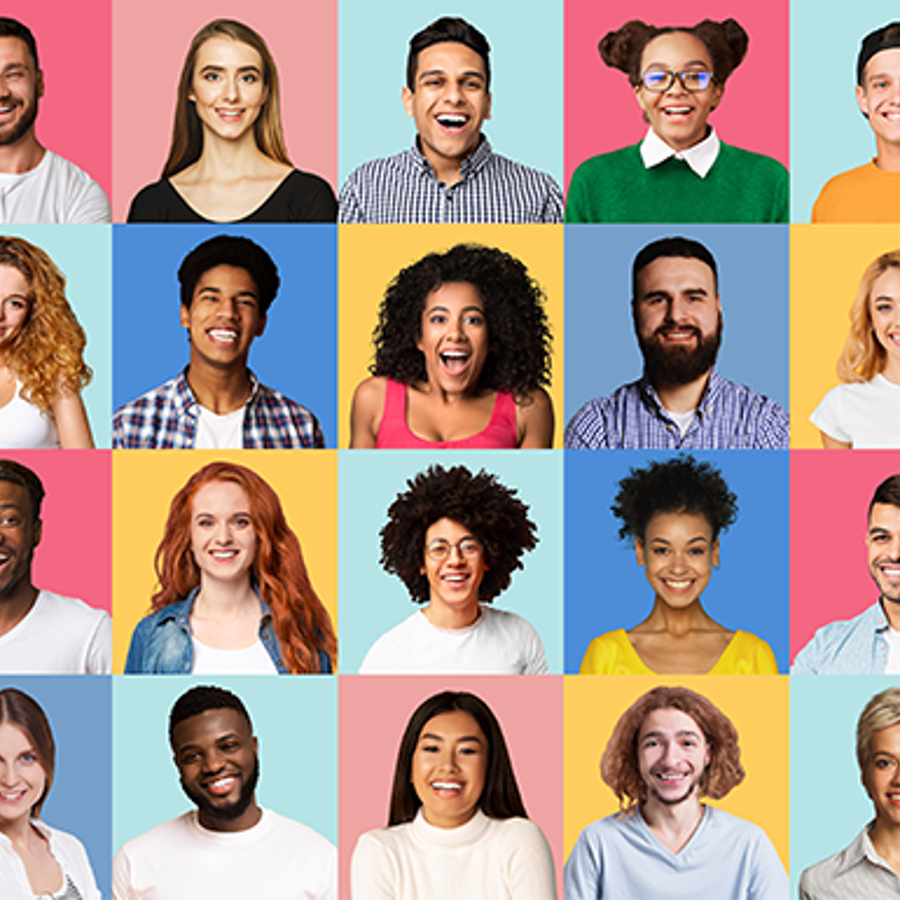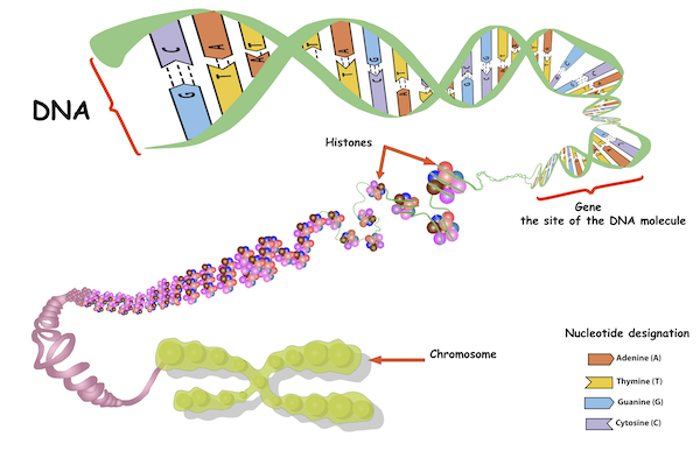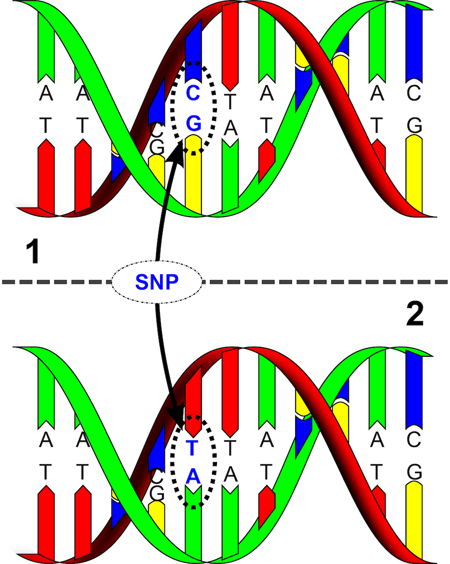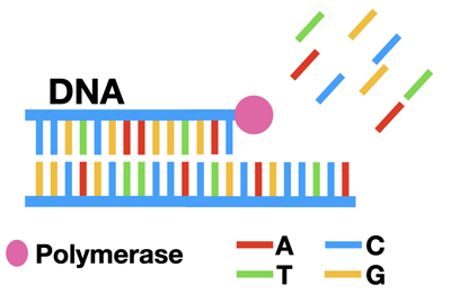
How many different combinations of people are possible?
October 24, 2012

- Related Topics:
- Quirky questions,
- Human evolution,
- Population genetics,
- Genetic variation,
- Bioinformatics,
- Genomics
A curious adult from Israel asks:
"How many different combinations of people are possible? I suppose it should be the number of genes multiplied by the number of alleles per gene, is that correct?"
The short answer is probably close to an infinite number of combinations. Let’s put our math thinking caps on and see how we can slice and dice this problem and arrive at a number.
Totally Random Genetic Combinations
As you hinted, variations in people boil down to genetics, which naturally brings DNA to mind. DNA is a string of chemical building blocks (called nucleotides) that carries instructions for making different molecules in the body. There are four different nucleotides (called A, T, C, and G).
Humans have a sequence of six billion nucleotides that make up their DNA, which is quite an astronomical number. One mathematical way to think about the total number of genetically unique humans is by completely jumbling their DNA.
If we randomly assign one of the four nucleotides into each of the six billion positions, we’ll end up with an even more astronomical number (4 to the 6 billionth power, to be exact). I couldn’t find a calculator powerful enough to compute this, so let’s just call it infinity.

But randomly jumbling DNA isn’t fair game because most of these jumbles would carry nonsense instructions. And some would stumble on the combination to make a cow or a moose or a daisy. There is a certain minimum amount of order needed for a DNA sequence to have the instructions to make a human.
One way to think about the set of human DNA is like a novel. Imagine taking a novel and jumbling all its letters — most of the new words will probably be gibberish. And you would be very unlikely to get anything similar to the same story.
This is where we need our biology thinking caps to help us. You mentioned genes and you’re on the right track!
Biology has Rules for Genetic Variations
Genes are cassettes of DNA sequences that instruct cells to make the proteins and enzymes required for life. Millions of years of evolution have organized about 20,000 human genes into 23 chromosomes. Since we inherit two sets of chromosomes, one from each of our parents, we have a total of 46 chromosomes.
It turns out genes make up only 1% of total DNA. That’s about 120 million nucleotides of coding DNA in both chromosome sets. These nucleotide sequences are largely identical among people.

Once in a while, though (around 1 every 1,000 nucleotides), you will see variations. You may have heard that humans are 99.9% genetically similar. These variations (scientists call them Single Nucleotide Polymorphisms, or SNPs) are where that number comes from.
Okay, back to figuring out total combinations of humans. If we jumble one nucleotide per every thousand in the 120 million coding DNA nucleotides, we’ll end up mutating at 120 thousand positions. Each position can be either A, T, C, or G. Quick math gives 4 to the 120 thousandth power combinations of SNPs.
This number is still too astronomical for my calculator. But it’s a much smaller number than what we computed earlier with jumbling all six billion positions. And we can lower it even more.

Lots of these SNPs will actually cause a person to die — they are lethal changes. Obviously we shouldn’t count those!
We don’t have a good number on this for people, but a few studies have been done on other beasts. For example, work on a virus showed that 40% of changes were lethal and around 30% were nonlethal but bad for you1.
Let’s just say that 50% of SNPs are not allowed because it results in a dead person. Now we are down to 4 to the 60 thousandth power combinations of SNPs. And we’re not done yet!
Most of the SNPs in human genes are neutral, meaning they don’t have any effect on the gene or how it works. It’s hard to pin down exact numbers, but I found one estimate that only 3 to 5% of the SNPs within genes have any noticeable effect. While these folks are different at the gene level, they aren’t any different on the outside. Two people with and without one of these changes behave identically.
So if only 3 to 5% of the SNPs make a difference, our prediction of human combinations comes down to 4 to the 2 thousandth power. We will need a really long piece of paper, because the numerical answer has about 2000 digits, which again is approaching the edge of infinity. But still, it is much less than before.
There are also SNPs that cause the same trait. For example, there are many different SNPs that lead to red hair. So if we lump these together, we lower the numbers even more.
Still, we are left with an awful lot of different people. And unfortunately, after all our trimming, we now have to add back possibilities. SNPs within genes are not the only things that make us different.
Other Rules
It turns out that SNPs are not the most common causes of genetic variations in humans. The nucleus that houses DNA is a very happening place. Through the course of evolution, DNA gets copied, chopped up, and moved around a lot.
If we had a super strong DNA scanner to study everybody’s DNA, we would see the same pieces of DNA in one person get deleted, inverted, inserted or duplicated in another person. These are called copy number variations. When these variations are included, humans share only 99.5%2 genetic similarity. And these aren’t the only culprits.

Remember our earlier discussion of genes making up for only 1% of our DNA? The remaining non-coding regions of DNA have been termed “junk DNA”. But scientists are increasingly convinced that they play important roles in controlling gene behavior, such as switching genes on and off. This can lead to physically observable differences that have to be added to our pool of different people.
I can go all day about details in human variations, but I will save it for another day. I will leave you with one other interesting fact though.
It turns out that human variations are not all in the DNA, but also in the chemical tags that attach to DNA. These tags act like switches that affect how DNA gets read by the cell. This highly exciting field of study is called epigenetics (epi = outer in Greek).
And don’t forget about nature vs nurture. Identical twins starting out with identical genetics at birth will look quite different when they are raised in completely different environments. And of course, their personalities will be different too.
Circling back to our initial hunch we see that we weren’t so far off in our estimation of infinity for human combinations. This means that the probability of you bumping into another human identical to you is one in infinity, or equivalently, zero. Unless of course you’re an identical twin. And then you still would have a few differences between the two of you!

Author: Widya Mulyasasmita
When this answer was published in 2012, Widya was a Ph.D. candidate in the Department of Bioengineering, studying regenerative medicine and protein engineering in Sarah Heilshorn’s laboratory. Widya wrote this answer while participating in the Stanford at The Tech program.
 Skip Navigation
Skip Navigation
